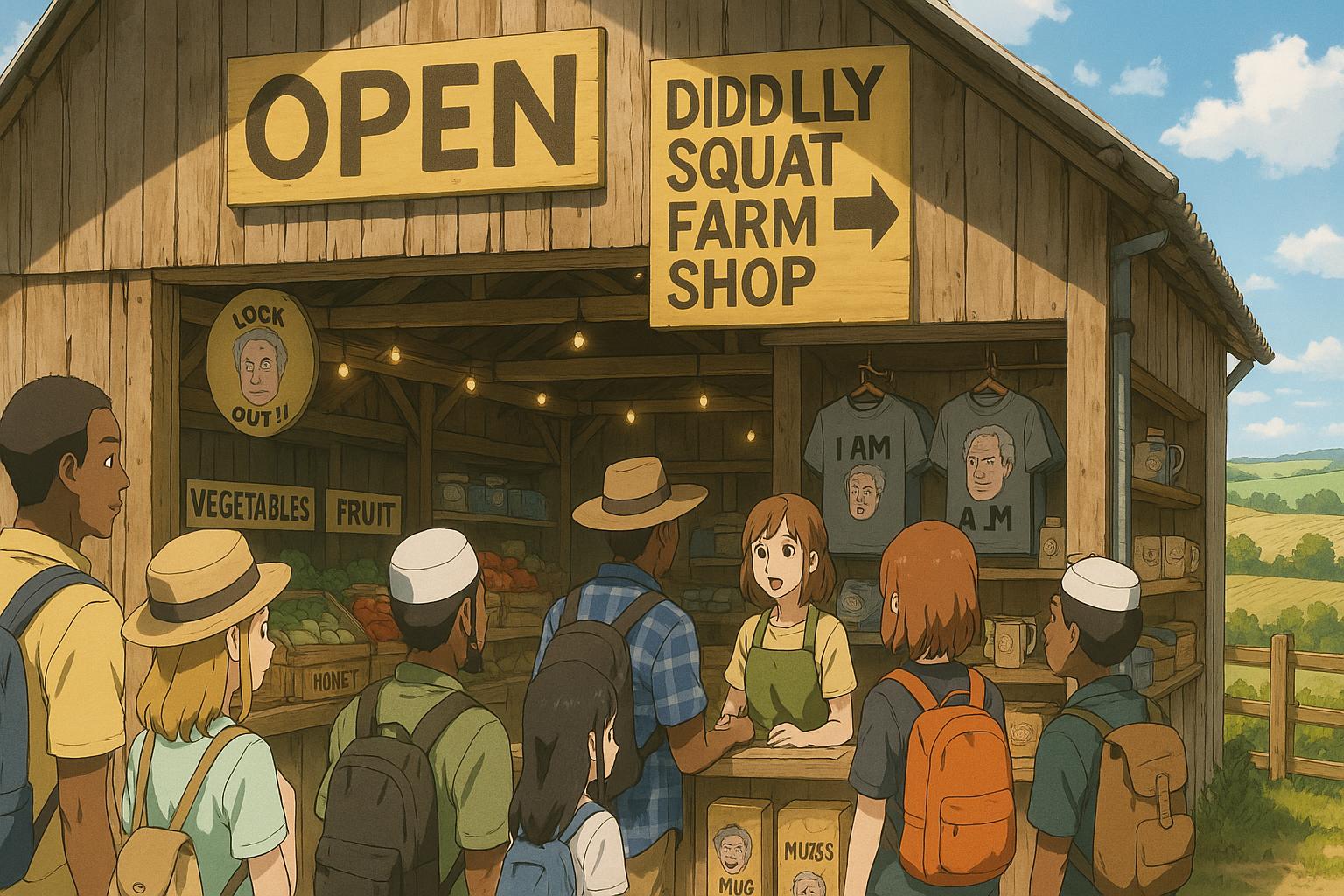Fans worldwide, especially from China, are drawn to Jeremy Clarkson’s Diddly Squat Farm by social media buzz and his Amazon Prime series, creating long queues and local traffic woes in the Cotswolds.
Large queues have become a defining feature at Jeremy Clarkson’s Diddly Squat Farm, nestled just outside the picturesque village of Chadlington in the Cotswolds. The former Top Gear presenter and now farmer, at 65, has transformed his 1,000 acre estate into a thriving rural business, cultivating crops like barley, wheat, asparagus, strawberries, and beetroot. The success of his Amazon Prime series, Clarkson’s Farm, has attracted a wave of visitors, much to the chagrin of local residents who have voiced concerns about overcrowding and traffic issues.
The farm shop—a rustic barn filled with everything from prime cuts of meat and fresh eggs to quirky souvenirs—has become a pilgrimage site for fans from across the globe. Visitors flock from the United States, Canada, Australia, and beyond, eager to purchase everything from cheese to branded chopping boards emblazoned with slogans like ‘Cow Juice.’ Recently, Clarkson has noted a significant increase in Asian tourists, particularly from China, who seem captivated by both the products and the charm of the farm. In an interview with The Times, Clarkson remarked, “It’s massively popular in China. A huge number of Chinese people come to the farm shop and the pub,” adding that one local Chinese visitor told him, “We watch it because we cannot believe how incompetent you are.”
Interestingly, many of the Chinese visitors arriving at Diddly Squat have not necessarily watched Clarkson’s series. Instead, they were introduced to the farm through social media platforms like Little Red Book, which share videos showcasing its unique products. For instance, Zhng and Celine Chen, two visitors from Xi’an, explained that they were drawn to the farm’s online presence—having seen alluring clips of its famous glass milk bottles and other merchandise. They reportedly decided to make the journey not out of curiosity about Clarkson himself, but simply because they found the local products appealing.
This social media influence reflects a broader trend wherein younger urbanites, particularly in China, are increasingly disconnected from agrarian lifestyles yet intrigued by them. The series has achieved a remarkable 9.6 out of 10 on Douban, with over five million views on Bilibili. As articulated by observers, “Clarkson’s Farm” presents a romanticised view of rural life that resonates distinctively against the ultra-modern life experienced by many young Chinese adults, contrasting sharply with their urban realities.
The influx of international visitors following the release of the third season of Clarkson’s Farm has brought a mix of excitement and strain to the local community. Reports indicate that by early afternoon, the car park is often full, leading to long waits and even warnings about potential parking tickets. While this surge in popularity has benefitted Clarkson economically, it also raises significant questions about local infrastructure and community disruption.
Local residents have expressed their frustration regarding the traffic congestion created by the influx of tourists, particularly on narrow village roads that are being misused as shortcuts by Google Maps. As a response, Clarkson himself has taken to his pub’s website, urging visitors to respect community routes and stick to main roads to alleviate pressure on the quaint villages surrounding his farm. He has also had tussles with local authorities over planning issues, illustrating the tension that can arise when rural charm meets commercial success.
Despite these challenges, the global appeal of Clarkson’s brand and his forays into farming have undeniably put Diddly Squat on the map. From family visits to casual tourist stopovers, it seems the marriage of entertainment and agriculture is creating a vibrant—if complex—new narrative for the Cotswolds and beyond. With crowds eager to experience a slice of rural life, Clarkson’s Diddly Squat Farm continues to thrive amidst the dilemma of balancing popularity with local concerns.
Reference Map
- Paragraph 1: [1], [4], [5]
- Paragraph 2: [1], [2], [6]
- Paragraph 3: [1], [2]
- Paragraph 4: [2], [3], [6]
- Paragraph 5: [1], [4], [5]
- Paragraph 6: [1], [6], [7]
- Paragraph 7: [1], [4], [5]
- Paragraph 8: [1], [5], [7]
Source: Noah Wire Services
- https://www.dailymail.co.uk/news/article-14714773/Jeremy-Clarkson-tourists-China-Diddly-Squat-Farm-Clarksons-Farm.html?ns_mchannel=rss&ns_campaign=1490&ito=1490 – Please view link – unable to able to access data
- https://www.theguardian.com/world/article/2024/may/24/funny-and-kind-of-sad-how-clarksons-farm-has-captured-chinese-viewers – This article explores the popularity of ‘Clarkson’s Farm’ among Chinese viewers, highlighting its 9.6 out of 10 rating on Douban and over 5 million views on Bilibili. It discusses how the show resonates with young urbanites unfamiliar with farming, offering insights into rural life and the challenges of agriculture. The piece also touches on the show’s appeal to Chinese audiences seeking a romanticized version of country life, contrasting it with the reality depicted in the series.
- https://www.express.co.uk/showbiz/tv-radio/1895743/Jeremy-Clarkson-Diddly-Squat-Farm-fans-clarksons-farm-3 – Following the release of the third series of ‘Clarkson’s Farm,’ Diddly Squat Farm experienced a surge in visitors, leading to long queues and a full car park by 1 pm. Fans from various countries, including the United States, Wales, and Germany, visited the farm to celebrate the new season. The article highlights the global appeal of the show and the challenges faced by the farm in managing the influx of tourists.
- https://www.oxfordmail.co.uk/news/24352721.clarksons-farm-tourists-warned-parking-tickets-queues-build/ – Tourists visiting Jeremy Clarkson’s Diddly Squat Farm in Chadlington were warned about potential parking tickets due to the overwhelming number of visitors following the release of the new season of ‘Clarkson’s Farm.’ The article discusses the challenges faced by the farm and local authorities in managing the increased traffic and the impact on the local community.
- https://www.examinerlive.co.uk/news/tv/jeremy-clarkson-issues-apology-diddly-squat-26403711 – Jeremy Clarkson issued an apology to visitors of Diddly Squat Farm after the farm shop experienced long queues and overcrowding due to the popularity of ‘Clarkson’s Farm.’ The article details the challenges faced by the farm in managing the influx of visitors and Clarkson’s commitment to improving the situation.
- https://www.nottinghamworld.com/watch-this/jeremy-clarksons-diddly-squat-farm-draws-massive-queues-4617085 – Following the release of the third series of ‘Clarkson’s Farm,’ Diddly Squat Farm saw massive queues as hundreds of fans flocked to the farm. The article provides insights into the global popularity of the show and the challenges faced by the farm in accommodating the surge in visitors.
- https://www.wigantoday.net/watch-this/jeremy-clarksons-diddly-squat-farm-draws-massive-queues-4617085 – This article reports on the overwhelming number of visitors to Diddly Squat Farm after the release of the third series of ‘Clarkson’s Farm.’ It highlights the global appeal of the show and the challenges faced by the farm in managing the increased number of tourists.
Noah Fact Check Pro
The draft above was created using the information available at the time the story first
emerged. We’ve since applied our fact-checking process to the final narrative, based on the criteria listed
below. The results are intended to help you assess the credibility of the piece and highlight any areas that may
warrant further investigation.
Freshness check
Score:
9
Notes:
The narrative appears to be recent and relevant, discussing ongoing issues with tourism and local infrastructure. However, specific details about the timing of events or recent updates are not provided, which could affect its freshness in the context of current events.
Quotes check
Score:
8
Notes:
The quote from Jeremy Clarkson is attributed to an interview with The Times, but no exact date is provided for verification. The quotes from visitors seem unique but lack specific sources beyond the narrative.
Source reliability
Score:
7
Notes:
The narrative originates from a reputable news outlet, the Daily Mail, which generally offers reliable information. However, the sensational nature of some reporting might affect the objectivity.
Plausability check
Score:
9
Notes:
The claims about Diddly Squat Farm attracting tourists and the impact on the local community are plausible and align with observed trends in rural tourism. The popularity of Clarkson’s series in China is also well-documented.
Overall assessment
Verdict (FAIL, OPEN, PASS): PASS
Confidence (LOW, MEDIUM, HIGH): HIGH
Summary:
The narrative appears to be generally accurate, discussing real events and trends. It is based on recent information and plausible claims. However, the lack of specific dates for quotes and events slightly reduces confidence in its freshness.













